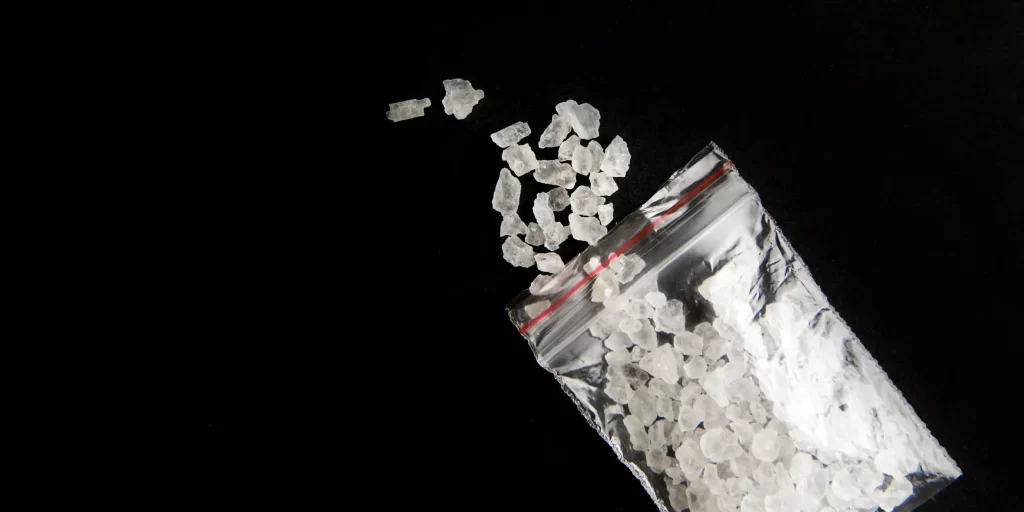How Long Do Bath Salts Stay in Your System?
Written by Renee Deveney
& Medically Reviewed by Dr. Jessica Pyhtila, PharmD
Medically Reviewed
Up to Date
Last Updated - 6/17/2022
View our editorial policy
The timeframe for how long bath salts stay in your system varies depending on the specific drug and how it is taken. Effects can be felt in less than 20 minutes and last as long as four hours. They can generally only be detected as long as 48-72 hours after use.
Over the past decade, the increase in bath salt use has been in the headlines. Although bath salts are synthetic and many have been made illegal, sellers can stay one step ahead of the law and change the chemical structure of the drug to keep selling it.
Because sellers are always creating new bath salts, there are many drugs in the category. Common bath salts include:
- Mephedrone
- Methylone
- 3,4-Methylenedioxypyrovalerone, or MDPV
- Methylethcathinone
- 3-fluoromethcathinone
- 4-fluoromethcathinone
- Buphedrone
- Butylone
- Methedrone
- Pentedrone
- Naphyrone
Duration of Effects of Bath Salts
Bath salts can be taken by various routes, including:
- By mouth
- By rectum
- Snorted
- Injected, sometimes with heroin
Each of these routes may have their own duration of effect. However, the oral route has been the most studied. When taken by mouth, bath salts usually reach their peak effect in about 1.5 hours. However, this can vary by bath salt. For example, MDPV reaches its peak concentration in less than 20 minutes.
After their peak effect, bath salts often last for about 4 more hours before wearing off. While a bath salt high can last up to 3 hours, the crash after the high can last for another 3 to 4 hours.
It is important to note, however, that since the term bath salts refers to multiple drugs, timeframes may vary. For example, a high from methylone can last from 1 to 4 hours. Conversely, a high from MDPV may last from 3 to 4 hours.
Short-term effects of a bath salt high include:
- Paranoia
- Seeing and hearing things that aren’t there
- Being more friendly than usual
- Higher sex drive
- Panic
- Agitation
- Violence
After coming down from a bath salt high, mood symptoms can persist for days. These symptoms include:
- Low mood lasting around 4 days
- Aches and pains lasting around 2 days
- Fatigue lasting around 2 days
Bath Salts Half-Life
Because the term bath salts is a catch-all phrase for many different drugs, the half-lives can vary. However, among the bath salts that have been studied, the drugs often have a short half-life. For example, mephedrone has a half-life of around 2 hours. The bath salt MDPV has an even shorter half-life, ranging from 78 minutes to just over 1.5 hours.
How Long will Bath Salts Show Up in Drug Tests?
Bath salts do not show up on most drug tests. Although some urine and blood tests exist for bath salts and their breakdown products, they are rare and expensive. For this reason, they are often limited to forensics. Even when they can be tested, bath salts cannot generally be detected after 48 to 72 hours after use. There are no saliva or hair tests for bath salts at this time.
A big problem with creating tests for bath salts is that there are many bath salt drugs, each with their own breakdown products. Every year, bath salt sellers create new products to try to get around laws that have made other bath salts illegal. Creating a test that captures all bath salts is, therefore, very hard.
However, researchers are working on creating more tests for bath salts. Within the past few years, a test has been created to test products for bath salts. Therefore, if you have a substance at home and are wondering if it contains bath salts, there are tests available. However, tests for bath salts in bodily fluids are generally not given.
How Bath Salts are Broken Down in the Body
Bath salts easily get into the brain after being ingested. There, they have a strong stimulant effect that is even more dramatic than amphetamines. Bath salts are broken down in the liver. Their breakdown products leave the body in the urine.
How to Get Bath Salts Out of Your System
There is nothing you can do to speed up the process of getting bath salts out of your system. Bath salts have to go through the breakdown process in the liver to be removed from the body. Someone with bad side effects from bath salts, such as aggression or agitation, may need to go to the hospital to be treated until the drug wears off.
Key Points: How Long Do Bath Salts Stay in Your System?
Important points to remember about how long bath salts stay in your system include:
- Many different bath salts exist, each with their own duration of effects and chemical properties.
- In general, a bath salt high lasts around 4 hours.
- A crash after a bath salt high often lasts another 4 hours.
- Mood symptoms after bath salt use can last for days.
- Currently, there are no common tests for bath salts in the body.
If you or a loved one struggle with bath salt or other stimulant use, help is here. Contact our trained, compassionate staff at Ridgefield Recovery to learn how we can help you.
We are here when you are ready.
Speak with a Recovery Advocate today to talk about your treatment options.
Sources
Ross EA, Watson M, Goldberger B. “Bath salts” Intoxication.” New England Journal of Medicine, September 8, 2011. Accessed August 3, 2019.
National Institute on Drug Abuse. “Synthetic Cathinones (“Bath Salts”).” February 2018. Accessed August 3, 2019.
Drug Enforcement Administration. “3,4-Methylenedioxypyrovalerone (MDPV).” July 2019. Accessed August 3, 2019.
Homman L, Seglert J, Morgan MJ. “An Observational Study on the Sub-acute Effects of Mephedrone on Mood, Cognition, Sleep and Physical Problems in Regular Mephedrone Users.”
Psychopharmacology, published June 26, 2018. Accessed August 3, 2019.
U.S. Department of Justice. “Background, Data and Analysis of Synthetic Cathinones: Mephedrone (4-MMC), Methylone (MDMC) and 3,4-Methylenedioxypyrovalerone (MDPV).” August 2011. Accessed August 3, 2019.
Haymarket Media. “High on Bath Salts: What to Know.” Clinical Advisor, November 28, 2011. Accessed August 3, 2019.
Majchrzak M, Celiński R, Kuś P, et al. “The Newest Cathinone Derivatives as Designer Drugs: an Analytical and Toxicological Review.” Forensic Toxicology, September 7, 2017. Accessed August 3, 2019.
Karila L, Megarbane B, Cottencin O, Lejoyeux M. “Synthetic Cathinones: A New Public Health Problem.” Current Neuropharmacology, January 2015. Accessed August 3, 2019.
Papaseit E, Pérez-Mañá C, Mateus JA, et al. “Human Pharmacology of Mephedrone in Comparison with MDMA.” Neuropsychopharmacology, October 2016. Accessed August 3, 2019.
Anizan S, Concheiro M, Lehner KR, et al. “Linear Pharmacokinetics of 3,4-methylenedioxypyrovalerone (MDPV) and Its Metabolites in the Rat: Relationship to Pharmacodynamic Effects.” Addiction Biology, March 2016. Accessed August 3, 2019.
View Sources
Ross EA, Watson M, Goldberger B. “Bath salts” Intoxication.” New England Journal of Medicine, September 8, 2011. Accessed August 3, 2019.
National Institute on Drug Abuse. “Synthetic Cathinones (“Bath Salts”).” February 2018. Accessed August 3, 2019.
Drug Enforcement Administration. “3,4-Methylenedioxypyrovalerone (MDPV).” July 2019. Accessed August 3, 2019.
Homman L, Seglert J, Morgan MJ. “An Observational Study on the Sub-acute Effects of Mephedrone on Mood, Cognition, Sleep and Physical Problems in Regular Mephedrone Users.”
Psychopharmacology, published June 26, 2018. Accessed August 3, 2019.
U.S. Department of Justice. “Background, Data and Analysis of Synthetic Cathinones: Mephedrone (4-MMC), Methylone (MDMC) and 3,4-Methylenedioxypyrovalerone (MDPV).” August 2011. Accessed August 3, 2019.
Haymarket Media. “High on Bath Salts: What to Know.” Clinical Advisor, November 28, 2011. Accessed August 3, 2019.
Majchrzak M, Celiński R, Kuś P, et al. “The Newest Cathinone Derivatives as Designer Drugs: an Analytical and Toxicological Review.” Forensic Toxicology, September 7, 2017. Accessed August 3, 2019.
Karila L, Megarbane B, Cottencin O, Lejoyeux M. “Synthetic Cathinones: A New Public Health Problem.” Current Neuropharmacology, January 2015. Accessed August 3, 2019.
Papaseit E, Pérez-Mañá C, Mateus JA, et al. “Human Pharmacology of Mephedrone in Comparison with MDMA.” Neuropsychopharmacology, October 2016. Accessed August 3, 2019.
Anizan S, Concheiro M, Lehner KR, et al. “Linear Pharmacokinetics of 3,4-methylenedioxypyrovalerone (MDPV) and Its Metabolites in the Rat: Relationship to Pharmacodynamic Effects.” Addiction Biology, March 2016. Accessed August 3, 2019.
Authorship






